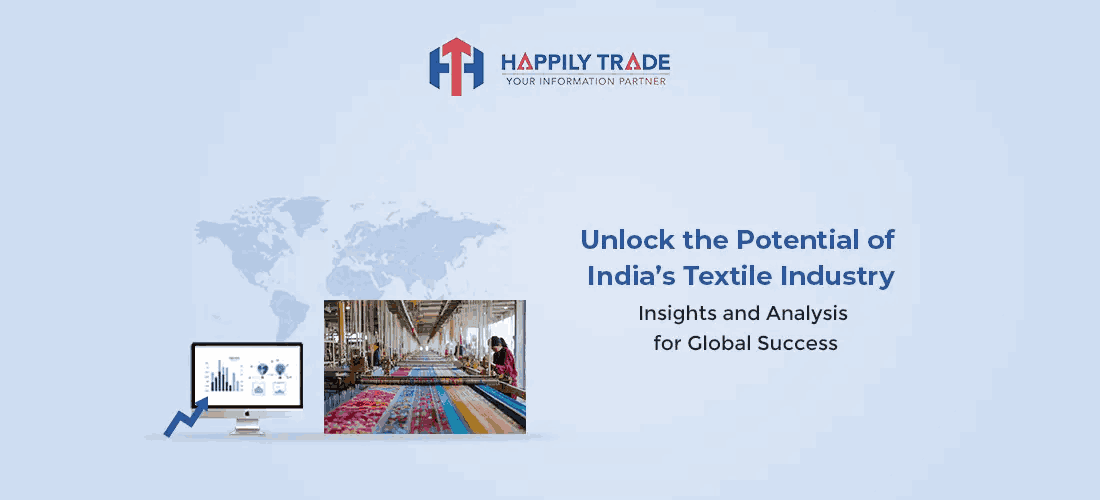India’s Textile Exports: Key Market Trends and Statistics
- Log in to post comments
India has long been a significant player in the global textile market, known for its rich heritage, skilled craftsmanship, and diverse range of products. The country's textile exports have grown remarkably, adapting to market demands and evolving trends. This blog explores the key market trends and statistics surrounding India's textile exports, shedding light on the factors contributing to their success and providing insights into import export data in India.
Overview of India's Textile Exports
India's textile exports are a crucial component of its economy, contributing significantly to its GDP and providing employment to millions. The textile sector encompasses many products, including cotton, silk, wool, and synthetic textiles. In the fiscal year 2022-23, India’s textile exports reached approximately $44 billion, reflecting a steady increase from previous years.
Key Contributors to Growth
Several factors have contributed to the growth of India's textile exports:
1. Diverse Product Range
India offers a wide variety of textiles, catering to both traditional and modern market demands. This diversity allows the country to effectively meet global needs.
2. Government Initiatives
The Indian government has implemented various policies and schemes to promote textile exports, such as the Production-Linked Incentive (PLI) scheme, which aims to boost manufacturing and enhance export competitiveness.
3. Sustainability Focus
With a growing global emphasis on sustainable and ethical practices, Indian textile manufacturers are increasingly adopting eco-friendly processes, attracting more international buyers.
Key Markets for India's Textile Exports
India's textile exports are distributed across various international markets, with significant demand from countries around the globe.
United States
The United States remains one of the largest importers of Indian textiles. According to import export data in India, around 25% of India's textile exports go to the U.S. market. This demand is primarily driven by the growing trend of casual wear and athleisure, where Indian manufacturers excel in producing high-quality cotton and blended fabrics.
European Union
The European Union is another major market for India's textile exports, accounting for approximately 20% of the total. Countries like Germany, France, and the UK significantly contribute to this demand. The EU's preference for sustainable textiles aligns well with India's increasing focus on eco-friendly production.
Middle East and Asia
The Middle East and Asian markets also play a crucial role in India's textile export landscape. Countries such as the UAE, Bangladesh, and China have shown a growing appetite for Indian textiles, particularly home textiles and garments.
Key Market Trends
1. Rising Demand for Sustainable Textiles
Consumers worldwide are increasingly conscious of environmental sustainability. This has increased demand for sustainable textiles, such as organic cotton, recycled fabrics, and eco-friendly dyes. India's textile industry has responded by investing in sustainable practices and developing innovative products to cater to this growing market.
2. Growing Popularity of Ethnic Wear
Ethnic wear, including traditional Indian garments like sarees, salwar kameez, and dhotis, has gained popularity globally. India's rich cultural heritage and exquisite craftsmanship have made its ethnic wear exports significantly contribute to the industry's growth.
3. Technological Advancements
Advancements in textile technology have enabled Indian manufacturers to improve efficiency, reduce costs, and enhance product quality. The adoption of automation, digital printing, and advanced fabric finishing techniques has played a crucial role in the competitiveness of India's textile exports.
Challenges Facing India's Textile Exports
While India's textile exports have grown substantially, several challenges still hinder the sector's potential.
Competition from Other Countries
India faces stiff competition from countries like China, Bangladesh, and Vietnam, which have established themselves as leading textile exporters. These countries often benefit from lower production costs and advanced manufacturing technologies, making it challenging for Indian exporters to compete on price.
Infrastructure Issues
Infrastructure deficiencies, such as inadequate transportation networks and limited access to ports, continue to pose challenges for the textile sector. These issues can lead to shipment delays, affecting the overall efficiency of textile exports.
Compliance with Global Standards
As international buyers increasingly demand compliance with stringent quality and sustainability standards, Indian textile exporters must invest in improving their production processes and ensuring adherence to these standards. This often requires significant investment in technology and training, which can be a barrier for smaller manufacturers.
Conclusion
India's textile exports have witnessed remarkable growth, solidifying the country's position as a global textile powerhouse. The industry's ability to adapt to changing market trends, embrace sustainable practices, and leverage technological advancements has been instrumental in its success. As India continues to invest in research and development, enhance infrastructure, and improve trade policies, its textile exports are poised for further expansion and growth.
Unlock Global Opportunities with Happily Trade EXIM

Happily Trade EXIM is your go-to source for comprehensive import export data in India and beyond. Our extensive importers database worldwide empowers businesses to identify potential partners and expand their reach in international markets.
Our meticulously curated data provides insights into market trends, competitor strategies, and buyer preferences, enabling you to make informed decisions. Whether you want to understand market dynamics or connect with reliable importers, Happily Trade EXIM offers the tools and resources you need to thrive in the global trade landscape.
Join us today and take the first step towards unlocking a world of opportunities for your business!







